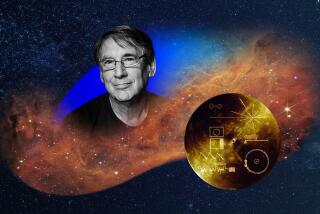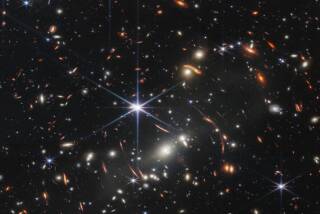âFar Out: A Space-Time Chronicleâ by Michael Benson
Far Out
A Space-Time Chronicle
Michael Benson
Harry N. Abrams: 328 pp., $55
In attending to 2009âs spectacular financial crisis, you may not have noticed that it was also the International Year of Astronomy, commemorating the twin 400th anniversaries of Galileoâs first telescopic observations and the publication of âNew Astronomy,â Keplerâs treatise on planetary motion.
But Harry N. Abrams, the king of coffee-table books, took note, weighing in with a 5-pounder that would have flabbergasted those two savants. Journalist and filmmaker Michael Benson, author of âBeyond: Visions of the Interplanetary Probesâ (also published by Abrams), has moved farther -- a lot farther -- into deep space in âFar Out,â amassing and musing on a collection of 228 spectacular âastrophotographsâ that reach all the way back to a few million years after the big bang. The earliest galaxies in the Hubble Space Telescopeâs Ultra Deep Field appear as little more than tiny reddish smears, but their light is 13 billion years old. Contemplating them gives you some notion of who you are and what you represent.
âItâs worth considering that what weâre seeing when we observe those earliest galaxies is a real-time transmission from timeâs edge,â the space-and-time-besotted Benson writes in his introduction, which will make your head spin. The images run from front to back (or west to east, as Benson oddly puts it) in order of their distance from Earth -- that is, from a mere 450 light-years away to the big bang neighborhood. You can leaf through âFar Outâ in either direction, Benson advises: âIf you start from its nominal beginning . . . and work your way east, youâll initially find yourself within a typical ancient barred spiral galaxy -- the Milky Way, circa 13 billion years old -- and progress to spaces deeper and times past. If you start from its eastern end and work your way west, youâll begin among the earliest galaxies . . . and end up in the distant future -- about 13 billion years later, within the contemporaneous cosmos. At the end, in other words, is the beginning, and at the beginning the end -- our local, ongoing end -- that is, the business end of timeâs arrow.â Got it?
While youâre wrestling with the idea that something can be both newly formed and 13 billion years old, and both there and (possibly) not there simultaneously (whatever that word might mean), itâs best just to look at the pictures, which are truly stunning. They include a four-page spread, 1foot by 3 1/2 feet unfolded, depicting the Milky Way as seen from our location on its Orion spur; the Eskimo nebula, âa distant face in a fur-lined parka hoodâ; the Tarantula nebula, 1,000 light-years across and fortunately about 160,000 light-years away; and four galaxies, 210 million to 340 million light-years away, on collision course with one another. Welcome to the real world.
Lippincott is a freelance editor specializing in science.
More to Read
The biggest entertainment stories
Get our big stories about Hollywood, film, television, music, arts, culture and more right in your inbox as soon as they publish.
You may occasionally receive promotional content from the Los Angeles Times.










